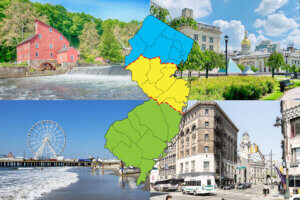The second installment of results from Monmouth University’s initial wave of a tracking panel of New Jersey residents who were displaced by Sandy finds that local municipalities are seen as the most responsive level of government during the recovery. These hardest-hit residents have found it fairly easy to register for state and federal recovery assistance, but are divided on how helpful these agencies have been.
A majority of respondents who were displaced by Sandy say that their local town government has been at least somewhat helpful (55%), compared to 42% who say it has not been helpful. Impacted residents are split on the federal government’s helpfulness – 51% say it has been helpful and 47% say not helpful. New Jersey state government is seen as less supportive – 43% helpful compared to 53% not helpful. County governments are seen as least helpful – 25% helpful to 62% not helpful.
There are few differences in county government helpfulness by region of the state – 39% of Middlesex residents, 26% of Monmouth residents, 25% of Ocean residents, and 21% of residents from other parts of the state say that their county governments have been helpful in the recovery. There are wider regional disparities for reports of municipal government help. Fully 86% of respondents from Middlesex County say their town governments have been helpful in the recovery, followed by 69% of Monmouth County coastal town respondents, 55% of Monmouth County bayshore respondents, 47% of Ocean County respondents, and 37% of respondents from other parts of the state. Among Ocean County respondents, those back in their homes (58%) are more likely than those who are still displaced (36%) to say their local government has been helpful. [Note: readers should keep in mind that towns are not proportionately represented in this panel sample.]
“Local governments have generally been seen as responsive in the year after Sandy hit. But there are some regional differences in local government ratings that suggest not all towns have been equally effective in working with their impacted residents,” said Patrick Murray, director of the Monmouth University Polling Institute, which is conducting the ongoing study under a grant from the New Jersey Recovery Fund.
Insurance providers get more negative than positive marks – 42% of impacted respondents say their insurance company has been helpful to 51% not helpful. Community organizations, such as the Red Cross and local churches get more positive marks (51% helpful) than negative (35% not helpful). Not surprisingly, the vast majority of impacted residents say that their family and friends (90%) and neighbors (74%) have been helpful in their Sandy recovery.
The first point of recovery for most impacted residents is through their insurance carriers. The vast majority of respondents in the impacted resident survey carried primary home coverage (92%) as well as federal flood insurance (80%). Among homeowners, 96% had primary coverage and 86% had flood coverage. Renters were significantly less likely to have carried any coverage prior to the storm; only 40% had a renters policy and just 18% carried flood protection.
Among those with primary home coverage, 87% filed a claim with their insurer. Among this group, 69% report that their claim was approved in whole or in part. Nearly all (99%) residents with flood coverage filed a claim and practically all of them had their claims approved (97%).
Insurance Provider Experience | ||
| Primary home insurance | Flood insurance | |
|
Had pre-Sandy coverage |
92% |
80% |
|
Among owners |
96% |
86% |
|
Among renters |
40% |
18% |
|
Filed a claim (among those with coverage) |
87% |
99% |
| Claim approved (in whole or part) |
69% |
97% |
| Insurer Responsiveness | ||
|
Very satisfied |
17% |
16% |
|
Somewhat satisfied |
28% |
33% |
|
Somewhat dissatisfied |
18% |
18% |
|
Very dissatisfied |
37% |
32% |
Despite the difference in claims experience, the overall levels of satisfaction with insurer responsiveness are similar for basic providers and flood providers. Specifically, 45% of residents who filed a primary home claim are satisfied with their carrier’s responsiveness. Slightly more of those who filed a flood claim (49%) are satisfied with that insurer’s responsiveness. There are some significant differences for primary coverage satisfaction depending on the claim’s outcome. Among those who had a primary claim approved, 56% were satisfied with their primary home insurer’s responsiveness. Only 22% of those whose claim was denied feel the same.
“Insurance providers get generally satisfactory, although not stellar, grades from New Jersey residents who were hardest hit by Sandy. It’s worth noting, though, that twice as many give insurers the most negative rating of very dissatisfied than the most positive rating of very satisfied,” said Murray.
The main government provider of recovery support is the federal government, particularly FEMA and the SBA. Overall, just 32% of impacted residents say it has been easy to get recovery information from federal agencies, compared to 54% who say it has been difficult. Survey respondents are more aware of some FEMA programs than others. Most know that FEMA provides rental assistance (75%) and transitional shelter assistance (68%). A majority are also aware of FEMA/SBA programs to provide home repair assistance not covered by insurance (57%), home repair loans up to $200,000 (56%), and temporary housing (55%). Fewer are aware of personal property replacement loans (41%) and assistance with “other than housing” needs (32%). About 1-in-10 (9%) respondents cannot identify any of the specific services provided by FEMA or the SBA.
Nearly all (98%) impacted residents surveyed say they registered with FEMA. Most report that the process was either very easy (28%) or somewhat easy (46%). Another 26% say the process was difficult. A majority of respondents (57%) report that FEMA denied them services or assistance they felt they needed. Applicants at both the lowest and highest income levels are most likely to report being denied FEMA services. Specifically, 67% of those earning less than $50,000 and 64% of those earning more than $150,000 report being denied by FEMA. This compares to 54% of those earning between $50,000 and $100,000 and 43% of those earning between $100,000 and $150,000 who report being denied FEMA assistance.
Another avenue of support is the state’s ReNew Jersey Stronger program administered through the Department of Community Affairs. Overall, just 32% of impacted residents say it has been easy to get recovery information from the state, compared to 52% who say it has been difficult. Still, at least 3-in-4 respondents say they have heard of state programs to provide $10,000 in-county resettlement grants (86%), up to $150,000 for rehabilitation or RREM (80%), and up to $30,000 for flood hazard mitigation (74%). Fewer have heard about forgivable loans for homebuyers (39%) and special Sandy Section 8 vouchers (17%). About 1-in-10 (9%) respondents cannot identify any of the specific services provided by ReNew Jersey Stronger.
Three-in-four (76%) impacted residents surveyed registered for ReNew Jersey Stronger assistance. Most report that the process was either very easy (32%) or somewhat easy (46%). Another 23% say the process was difficult. There are some income differences in ease of registering with the state that were not found with the FEMA process. One-third – about 34% – of residents earning less than $75,000 a year say they had difficulties registering with ReNew Jersey Stronger, compared to about 14% of those who earn more than $75,000 a year.
Less than half (45%) of those who registered with the state report that they were denied services or assistance they felt they needed. Applicants in the highest tier of income earners (56% of those earning more than $150,000) are the most likely to report being denied state services. This compares to between 41% and 46% of those earning between $50,000 and $150,000 and 35% of those earning less than $50,000 who also report being denied ReNew Jersey Stronger assistance.
“It appears that New Jersey families at the lower end of the income scale have had more difficulties obtaining FEMA or SBA services than assistance from the state, although they may have had a harder time registering for the state program,” said Murray.
While most local agencies do not provide financial support, they can be an important conduit of information about the recovery process. About one-third of respondents (35%) say that they are in contact or receive communications from municipal officials at least a few times a month, while 15% say they hear from their town at least once a month. Another 26% are in contact with town officials less often and 24% say they never have contact with their local government about the recovery effort. These results are nearly identical for respondents who are displaced and those who have been able to return home. Respondents from Monmouth County (44%) and Middlesex County (43%) are more likely than those from Ocean County (24%) or elsewhere in the state (10%) to report being in frequent contact with local municipal officials.
Half (50%) of the survey respondents say that it has been easy to get information about recovery and rebuilding from their local municipal government, compared to 41% who say it has been difficult. Respondents from Monmouth County shore towns (67%) and Middlesex County (62%) are most likely to say that communication with their local government has been easy, followed by respondents from Monmouth County bayshore towns (49%), Ocean County (41%) and elsewhere in the state (41%). However, Ocean County respondents who are back in their homes (50%) are more likely than those who are displaced (31%) to say that it is easy to get information from their local government. There is no such difference among Monmouth County residents who are back in their homes or still displaced.
County governments are not seen as positively as municipal governments when it comes to communications. Just 19% of survey respondents say it is easy to get recovery information from their county government, compared to 43% who say it is difficult. There are few substantial differences on this question across different parts of the state. For example, residents of Monmouth County’s bayshore (19% easy to 45% difficult), Monmouth County’s coast (25% to 35%), Ocean County (26% to 46%), Middlesex County (21% to 42%), and other parts of the state (17% to 38%) give fairly similar responses.
Survey respondents are split on the ease of communicating with other entities about the recovery effort. Thirty percent say it has been easy to get information from their gas utility provider while 25% say it has been difficult. A similar 29% percent say it has been easy to get information from their electric utility provider while 26% say it has been difficult. Also, 38% say it has been easy to get information from charitable and community organizations while 27% say it has been difficult.
Respondents were also asked about the best methods to provide recovery information. Most (63%) say that they rely on Internet websites and more than 4-in-10 (43%) also use social media. Just under half (45%) say that newspapers are also a preferred source. One-third (36%) would like to get emails from government agencies or recovery organizations and 28% would like automated reverse-911 calls. Another 28% say they look for TV and radio news reports. Twenty percent say that mailed notices would be effective and 12% say the same about flyers or doorhangers.
Future reports from this project will the track ongoing recovery progress and concerns of the impacted New Jersey residents participating in this panel.
Methodological Note:
The Monmouth University Polling Institute conducted this Sandy Recovery Survey online and by telephone with 683 New Jersey residents who were displaced from their homes for a month or more due to Superstorm Sandy. The results presented in this report were based on interviews completed between September 18 and October 21, 2013. This survey is part of a larger panel study designed to track the experiences of New Jersey residents who continue to be impacted by the storm. Because survey respondents were recruited using a variety of non-probability methods, the survey results cannot be statistically projected to the larger population of all Sandy victims in the state. The value of these survey findings rests in the internal poll comparisons (e.g. variations between those who remain displaced and those who are now back in their homes, variations by income levels, etc.) as well as to future waves of interviews that will track recovery progress for these individuals.
This project was designed to complement Monmouth University’s statewide and regional poll tracking of Sandy issues and specifically to highlight continuing issues in New Jersey’s Sandy recovery and provide recommendations for improving communication channels between hardest-hit residents and public/private authorities. This project was made possible by a New Jersey Recovery Fund grant from the Community Foundation of New Jersey and the Geraldine R. Dodge Foundation.
The questions referred to in this release are as follows:
1. How helpful have the following been in helping you recover from Sandy?
Your local town government
Your county government
State government, including the ReNew Jersey Stronger recovery program
Federal government, including FEMA and the SBA
Community organizations, such as the Red Cross and churches
Your family and friends
Your neighbors
Your insurance company
2. Are you aware of any of the following federal assistance programs that were made available to residents affected by Sandy?
Rental assistance (money to help pay for another place to live)
Transitional shelter assistance to pay for a hotel/motel stay
Repair assistance grants for costs not covered by insurance to make a damaged home safe/functional
Loans of up to $200,000 to repair a primary home
Temporary housing (a government provided home or trailer when rental places are unavailable)
Loans of up to $40,000 to replace personal property
Assistance with “other than housing” needs – such as medical, transportation, personal property, etc.
Not aware of any specific federal assistance programs
[The following question was asked of the 98% of the sample who registered for FEMA/SBA assistance.]
3. How was the process to register for FEMA/SBA assistance?
4. Are you aware of any of the following assistance programs that were made available from the New Jersey State Department of Community Affairs (NJDCA) ReNew Jersey Stronger program? Please check all of those that you have heard of.
$10,000 resettlement grant if you stay in the same county
Up to $150,000 for rehabilitation, reconstruction, elevation and mitigation of your damaged home
Hazard mitigation – up to $30,000 to elevate your home if you are in a 100 year floodplain
Homebuyer assistance – up to $50,000 in no-payment loans that are forgiven if you live in the same house for five years
Special Sandy Section 8 housing vouchers
Not aware of any specific state assistance programs
[The following question was asked of the 76% of the sample who registered for NJDCA ReNew Jersey Stronger assistance.]
5. How was the process to register for NJDCA ReNew Jersey Stronger assistance?
6. In the past few months, how often have you been in regular contact with or received communications by phone, mail, or email from officials in the town where you lived when Sandy hit?
7. Thinking more recently, how easy or difficult has it been to get information about recovery and rebuilding from each of the following sources over the past few months?
Your town government
Your county government
State government, including the ReNew Jersey Stronger recovery program
Federal government, including FEMA and the SBA
Your electric utility company
Your gas utility company
Charity/Community organizations, such as the Red Cross and churches
Click on pdf file link below for full methodology and results by key demographic groups.




